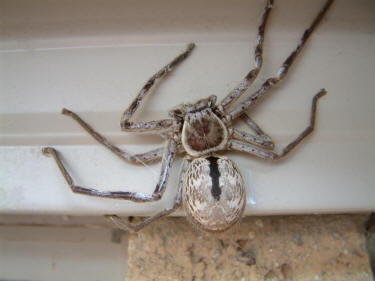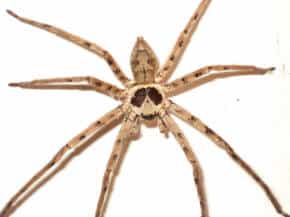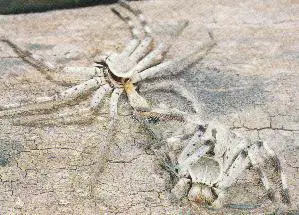Scientific Name: Delena, Holconia, Neosparassus, Olios.
There are around a hundred different species of huntsman spider in Australia. The two back pairs of legs are shorter than the ones at the front and the legs fan out sideways enabling them to walk forwards and sideways often giving them a crab-like appearance. They come in a variety of colours and patterns but are mostly brown, black and grey.
Some species are very large reaching over 160 mm (6 inches) in leg span. Huntsman spiders are those long-legged spiders we often surprise crawling around our ceilings at night. They are part of the “modern” spider species which breathe through trachea as well as through “book-lungs”. They also have chelicerae which close side to side. The legs of a huntsman spider fan out sideways and the joints bend forwards. This means these spiders can run sideways as well as forwards – useful under bark and among stones.


The huntsman eats a variety of insects, arthropods, small lizards and frogs.
The prey is not captured in a web but actively stalked and run-down with stealth and speed. The fangs are large and powerful and hold the food item until it is immobilised by the spider’s venom. Although bites can be painful to humans and occasionally cause mild nausea and headaches, the symptoms are usually only localized pain and swelling.
Huntsman spiders originally lived in woodlands and forests but today they take up residence on the walls of houses, hunting insects at night. If threatened, a huntsman spider will “play dead”, to avoid danger. Groups of huntsman may be found huddled together in a family group, under flaking bark or rocks.
Huntsman spiders moult and often their old skin may be mistaken for the original spider when seen clinging to bark or in the house.
Male and female huntsman have a lengthy courtship, which involves mutual caresses. The male is rarely attacked, unlike some other species. A female huntsman places her egg sac under bark or a rock, then stands guard over it. She tears the egg sac open to help the spiderlings emerge and stays with them for several weeks.
For more great pictures of Australian Huntsman Spiders, visit Ed Nieuwenhuys’ Page.

Click here for more photos of Huntsman Spiders.
Information and pictures were taken from children’s projects and where credited to that child does not claim to be original information. Where possible, permission to reproduce has been sought. Any infringement of copyright is purely unintentional.
